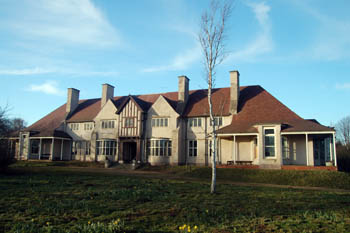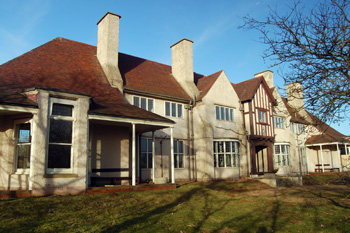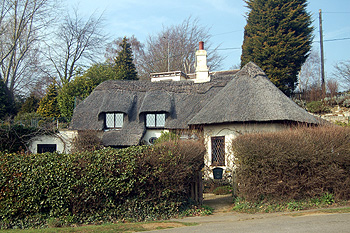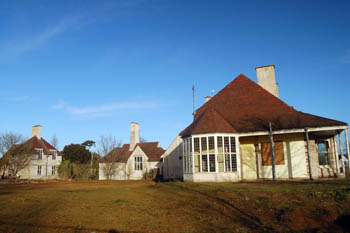Maryland Woburn

Maryland front view February 2008
Maryland Hospital was built between 1901 and 1903 by Mary, Duchess of Bedford and wife of the 11th Duke of Bedford. The architect was Henry Percy Adams whose designs were based on a sketch plan by the Duchess herself. The property was listed by English Heritage in August 2003 as Grade II, of special interest. A key feature was a ward at each end of the building, each of which incorporated a large sun lounge. The listing describes Maryland as: “One of the best preserved early 20th century cottage hospitals”. Bedfordshire and Luton Archives and Records Service has the original ground and first floor plans [R1/1023/1-2]
The Bedfordshire Times had an article on the hospital in their edition of Friday 29th May 1903 which reads as follows: “Beautiful for situation, charming in style, and complete in every detail is the model Cottage Hospital which Her Grace the Duchess of Bedford has built for Woburn and the rural parishes of the neighbourhood, viz. Husborne Crawley, Ridgmont, Eversholt, Milton Bryan, Potsgrove, Battlesden, Little Brickhill, Bow Brickhill, Hockliffe, Tebworth, Wavendon, Salford, Toddington, Tingrith, Steppingley and Lidlington. Apparently Woburn Sands and Aspley Guise are not included because of their semi-urban and more well-to-do character. It has been rather more than two years in the building, and on the afternoon of Friday, the 22nd May, it was open to the inspection of visitors by invitation. On Saturday it was open to inspection by the public generally. The Hospital takes the place of one which was very well equipped but on a smaller scale near the Woburn Town Hall, but we gather that it was Her Grace’s desire to have the very best Hospital of its character that modern medical and sanitary science could devise. The architect is Mr. H. Percy Adams F. R. I. B. A., who, it will be remembered, was the designer of the County Hospital at Bedford – an institution which remains the pride of all its supporters, and a standing credit to Mr. Adams, who is now building a large hospital at Newcastle and has been appointed by His Majesty’s Committee on Hospital Building to investigate foreign hospitals, and build a hospital which is to commemorate the late Queen Victoria. The builder is Mr. S. Foster of Kempston, and his name is a guarantee of sound workmanship”.
“The new Cottage Hospital is built on a breezy height near the small Police Station on the Leighton-road. It commands on all sides a beautiful view of hill and valley, diversified with pines and pastures and golden gorse, which looked their best on Friday in the bright sunshine of early summer. The style chosen for the building is Old English, and true to the character of a Cottage Hospital. The white roughcast walls contrast agreeably with the light green timberwork and deep reddish tint of the steep tiled roofs and four tall chimney stacks. In the middle of the front elevation are three gables of which the central one is quaintly timbered, forming the porch of the main entrance, which is approached by a short flight of stone steps. The ducal arms are emblazoned on the panel over the entrance. The front aspect is south-east, and therefore exposed to the best sunlight of the forenoon, while the outlook in that direction is full of colour and variety. The upper windows are plain Old English casements, glazed in lead, and the porch is flanked by bow windows in the old style. Other windows have large panes and ordinary sashes. At each end of the main building there is a chamber in which lead-glazing takes the place of walls. These are the sun rooms for the male and female patients, respectively, and each opens upon a verandah supported by columns and extending a little distance along the front. A terrace covered with smooth turf occupies the immediate foreground, and between that and the road the ground has been made up and turfed to form an elevated and perfectly level lawn, which has been planted with silver birch. A low rough cast wall and iron fence borders the road, and the bank within is planted with young rhododendrons – the glory of Woburn in their season. A substantial gate opens upon a carriage drive, and the spacious grounds are tastefully laid out. An inspection of the external arrangements shows that every thoughtful provision has been made in the drainage and sanitary appliances, and there is a good deal of evidence of first-class plumbing. The hospital buildings consist of a front block containing the wards which are all on the ground floor, and the administrative department, which is on the first floor. A corridor with cross-ventilation communicates with the domestic offices. At a little distance in the rear there is an isolation block for such infectious cases as occur on the premises , and this has a large coachhouse at the back, already provided with a fine hospital carriage with rubber-tyred wheels and well-mounted on springs. In a secluded spot, behind a bank planted with shrubs stands a small mortuary, for which, in an institution so well-favoured, we can only hope there will be very little use”.
“The internal arrangements of the Hospital were designed by Her Grace, who has throughout taken the deepest interest in the progress of the work, and at the opening on Friday – though there was no formal ceremony – the Duchess was most kind in receiving the visitors and giving them every information. The Duke of Bedford was also present, conversing with the visitors and showing every interest in this benevolent undertaking. The features that first impress themselves on a visitor’s attention are the antiseptic principles that prevail throughout, and the arrangements for cross-ventilation. The former makes for perfect cleanliness and the latter sweetens the air, prevents draughts, and effectually shuts off smell of cooking from the kitchen and ventilation from one part of the building into another. The principal wards are at the extreme ends of the front block, and provide for four men, four women and two children, and are about the same in size and character, with pleasant aspects from the window towards the south. Visiting the men’s ward, we find a commodious apartment, containing three beds and a cot. The dados are of glazed tiles, with border and decorations in pleasing colours, and handsome treatment round the fire-place. The upper parts of the wall are treated with white enamel, and all angles – whether between wall and floor, wall and ceiling, or in the corners – are rounded, while the teak floor boards are loosely fitted, so that no dust can be harboured anywhere, and perfect cleanliness is made easy. In the foot of the walls there is a ventilator to each bed, fitted with plate and a cloth strainer which admits air and excludes dust. At the top of the walls there are other ventilators, which are easily regulated. We understand that Maple’s have done the furnishing, and needless to say, the beds and their equipment are all that the Duchess of Bedford’s study of hospital work and the best advice can suggest. Ambulance wagons, fitted with glass shelves and stocked with antiseptic dressings, medicaments, and every requisite, can be wheeled from bed to bed as required. There are glass tables, tables with enamelled or marble tops, luxurious arm chairs for the patients, glass shelves on enamelled brackets near each bed for the medicine bottles, little lockers for toilet requisites, and an electric bell to each bed. The bed-table is an admirable idea. It slides over the bed linen and van be taken close up to the patient, who supported by pillows on a light bed-rest, is enabled to read or comfortably pass the time in such in such occupations as the table will make possible. The Duchess exhibited some macramé work which had been made by patients at the other Hospital. There is a touch of thoughtful anticipation in the toys that await the juvenile inmate of the ward. Superior electric light fittings are provided everywhere, and in the wards the central electrolier has a small pendant to play the part of a night-light. Connected with each ward is the sun-room already referred to, opening upon the verandah. The sun-rooms are warmed with hot-water pipes, and look out upon an extensive and charming prospect. There are also hot-water radiators in the wards. Everything is so well and thoughtfully that they that are whole could almost wish they were sick for the privilege of a sojourn in such pleasant quarters. Adjoining each ward there is a smaller apartment containing one bed for a patient form whom special treatment of quietness is deemed desirable. An inspection window in the wall dividing the two wards enables the nurses in one room to keep an eye on the patient in the other. The nurses have their own quarters elsewhere, but there will be night nurses on duty in the wards. There is also a well appointed surgery near the wards, and a reception room”.

Maryland three quarter view February 2008
“The corridors are offices are everywhere paved with handsome inlaid mosaic of smooth and exquisite workmanship, all angles being avoided. The wood-work generally is of teak. There is a peculiar charm about the handsome teak staircase from the hall to the upper floor. It is well lighted from the large lead-light windows, and in a quaint recess under the stair a book is kept for visitors’ names. The laboratories and bath-rooms are cut off from the corridors by cross-ventilation through easily adjusted glass slats. All sinks, fittings and walls are of such washable substances as porcelain, enamelled tiles and bricks, or surface of enamel-paint. The flushing apparatus leaves nothing to be desired, and there are ventilated cupboards for the patients’ clothing. The day-room for the patients is comfortably furnished; it has attractive pictures on the walls, and a cheerful outlook from the windows. The apartments for the Matron and the nurses are also elegantly furnished, and show that Her Grace has carefully ministered to the comfort of the staff. Precautions against fire have not been forgotten. Buckets, some containing water and others sand, hang in an easily accessible spot. Linen and store rooms for house-keeping purposes have been stocked with necessaries. Especially important and interesting is the operating theatre and it is scarcely necessary to say that the antiseptic arrangements here reach the acme of perfection. It is a marvellously well-lighted room, lined with white tiles and having large panes of the clearest glass exposed to the unobstructed north-west sky. Over the operating table or couch hangs an electrolier of three bulbs, which can be moved in any direction, and an electric-lamp for use in closer inspection can be attached to a fitting in the wall. Glass cases containing complete sets of instruments and antiseptic dressings of every description are at hand. Marble and porcelain sinks, with silver fittings, are also provided. The hot-water radiators are movable as on hinges and can be brought out into the room”.
“On the upper floor are five neatly and comfortably furnished bed-rooms for nurses, who have also a kitchen in proximity to the wards for preparing food, poultices, fomentations, and other requirements for the patients. The kitchen for the general cookery is in the domestic block, and is especially well equipped with range and utensils, and wash basins and sinks are of porcelain or similar material. Mention should be made of the fact that there is telephonic communication with the wards and all parts of the hospital”.
“In the basement are the hot-water boiler and furnace, and especially interesting is the installation for generating and storing electricity. One room contains a fine 8 break patent Robey oil engine, which drives a dynamo of 35 amperes. The switch-board alone would deeply interest an electrical engineer. It is a very handsome apparatus and seems to carry every kind of appliance likely to be required, inch an ingenious automatic cut-out, which guards against the dynamo being reacted upon by the storage battery, which is constructed in an adjoining room. There are 54 cells of two volts each in the storage battery, and presumably this system is best adapted to the needs of an institution where quietness is desirable, especially during the hours of the night, though we should imagine there would be no vibration from machinery well away from the vicinity of the wards and in the basement of a building so solidly constructed. Everything is in neat and excellent order, and even in the battery-room the air seems fresh and exhilarating, as though oxygenated by the action of the cells. The large cooling tanks in the engine-room and the heating apparatus remind us that the water supply from the well in the local Greensand is exceptionally pure and copious, and that it is pumped by electric power into the tanks necessary for distribution to all parts of the premises. There is also a lift from the basement to the top of the building for conveying wood, coal and other heavy articles. A practical engineer is in constant attendance”.
“The isolation block has three bedrooms, day or living-room, kitchen, and other offices – in all eight rooms – with furniture and fittings in the same excellent style as in the main building. This, of course, is not intended for the reception of infectious cases in the first instance (typhoid being excepted), but for a case that may occur in the Hospital after reception for some other cause, and in the category of infectious diseases we believe influenza is included”.
“The staff consists of Miss Young, the Matron, late of the London Hospital, and two trained nurses (Miss Hickley and Miss Kay), one for the Hospital and the other for the district, and both fully certificated from the London Hospital. The patients will be attended by their own doctors on whose recommendation they are admitted, with the sanction of the Duchess of Bedford. Preference is given to those least able to obtain good nursing in their own homes, and particulars should be sent to the Matron 24 hours before the patient is admitted, but accidents and urgent cases may be admitted on the responsibility of the Doctor or Matron. There will be no charge for admission. Patients may be attended by their ministers at such times as may be approved by the Matron, and, by her permission, friends may visit the patients on Sundays, Tuesdays and Thursdays from 2 to 4 p.m. Only two persons will be allowed to see a patient on any one day. In special cases permission will be given for visiting at other times. The rules are few, simple, and such as are usual in such institutions”.
“There were close upon three hundred invitations issued on Friday, and judging by the throng there were few who were unable to avail themselves of the opportunity. The Duke and Duchess were present with a party which included Major and Mrs. Haines, Major and Mrs. Rawlins, and Mr. and Mrs. Prothero of Oakley House. Visitors were shown round by the Duchess and Her Grace’s secretary, Miss Hamilton Brown, Miss Young, the nurses, Mr. Prothero, Mr. Brown and others. The visitors were also hospitably entertained to tea and light refreshments from the Abbey, and served in a large marquee by a staff from Gunter’s, as well as by the Abbey staff. The Hospital was open to visitors from 3 until 7 p.m. and the occasion was favoured with glorious weather. The visitors invited were the clergy, doctors, district councillors, parish councillors and tenant farmers in the district concerned. The Hospital was open to the public on Saturday from 3 to 7 p.m. and a large number attended. On the same day the three patients in the old hospital were removed to their new and beautiful quarters where probably they would fain linger longer and finally recover”.
The Rating and Valuation Act 1925 specified that every building and piece of land in the country was to be assessed to determine its rateable value. Woburn, like much of the county was valued in 1927 and the valuer visiting Maryland [DV1/C126/116] noted it was a “Hospital supported by Her Grace” and that total accommodation was twelve beds. The rooms on the ground floor of the main block were noted as: a nurses’ dining room’ a dispensary; a single patient’s room; a men’s ward with five beds; a sun room; an x-ray room with Cox Cavendish x-ray apparatus; a dark room (for developing the x-rays once taken); a verandah room; an x-ray waiting room; a men’s clothing room; the nurses’ kitchen; a sterilising room; an operating theatre; a bathroom; another sterilising room; a general kitchen; a scullery; a larder; a nurses’ pantry; a surgeon’s dressing room; a women’s clothing room; a W. C.; a bathroom; the women’s ward with five beds; a single patient’s room; a store room and the matron’s room.
The first floor of the main building contained: a nurses’ bathroom; a W. C.; four nurses’ bedrooms; a sister’s bedroom; the matron’s bedroom; the cook’s bedroom; a cupboard room and a linen room.
The isolation block comprised: a single patient’s room; a kitchen; three bedrooms; a bathroom; a garage; a mortuary; a bicycle shed and a trap house. There was also an engine house containing two engines one of fourteen horsepower run by gas and one of sixteen horsepower run by oil; there were also two batteries each of fifty four cells for a total of 112 volts. The grounds comprised 2.77 acres.

Birdcatchers Cottage March 2012
The valuer also noted: “Birdcatcher’s Cottage 1 room To be used as Nurses’ rest room”. Clearly today’s Birdcatcher’s Cottage is a substantial enlargement of that premises. The valuer was impressed: “Very, very good. Must have cost a fortune”.
Directories for Bedfordshire were not published every year but every few years from the mid 19th century until 1940. The matrons listed are as follows: Miss C. Hickley, 1910 and 1914; Miss Armstrong 1920, 1924, 1928 and 1931; Miss Davidson 1936. The various medical officers listed are as follows: John Waugh 1910 and 1914; Robert L. Brander 1910 and 1914; Charles C. Smith 1910 and 1914; Thomas D. H. Holmes 1910, 1914, 1920 and 1924; Bryden Glendinning 1920 and 1924; William Farrer Thompson 1920, 1924, 1928 and 1931; W. H. Ogilvie 1931 and 1936; Helen E. M. Barnes 1931 and 1936 and G. Massie 1936.
The Bedford Record reported that the former hospital was to be turned into an adult education centre in 1964 and in 1966 Bedfordshire County Council purchased the site and buildings from the trustees of the Bedford Estate [CCE2160/7] as a residential centre for adult education. The building continued to be used for educational purposes into the 21st century but closed shortly after the turn of the millennium and stood empty for some years before being sold and, inevitably, turned into luxury flats which came on the market in 2013.

Maryland from the side February 2008